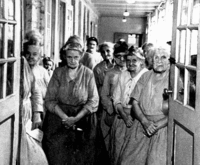Poorhouse
This article needs additional citations for verification. (March 2011) |

A poorhouse or workhouse was a government-run facility in the past for the support and housing of dependent or needy persons, typically run by a local government entity such as a county or municipality.
In England, Wales and Ireland (but not in Scotland[1]) a poorhouse was more commonly known as a workhouse. In early Victorian times (see Poor Law), poverty was seen as a dishonourable state caused by a lack of the moral virtue of industriousness (or industry as it was called). As was depicted by Charles Dickens, a workhouse could resemble a reformatory and house children, either with families or alone, or a penal labour regime to give the poor work at manual labour and subject them to physical punishment. As the 19th century progressed, conditions became better.
The term is commonly applied to such a facility that housed the destitute elderly; institutions of this nature were widespread in the United States prior to the adoption of the Social Security program in the 1930s. Facilities housing indigents who are not elderly are typically referred to as homeless shelters, or simply "shelters," in current usage.
Often the poorhouse was situated on the grounds of a poor farm on which able-bodied residents were required to work; such farms were common in the United States in the 19th and early 20th centuries; it could even be part of the same economic complex as a prison farm and other penal or charitable public institutions.
Poor farm
Poor farms were county or town-run residences where paupers (mainly elderly and disabled people) were supported at public expense. They were common in the United States beginning in the middle of the 19th century and declined in use after the Social Security Act took effect in 1935 with most disappearing completely by about 1950.
Most were working farms that produced at least some of the produce, grain, and livestock they consumed. Residents were expected to provide labor to the extent that their health would allow, both in the fields and in providing housekeeping and care for other residents. Rules were strict and accommodations minimal.
Poor farms were the origin of the U.S. tradition of county governments (rather than cities, townships, or state or federal governments) providing social services for the needy within their borders; the federal government did not participate in social welfare for over 70 years following the 1854 veto of the Bill for the Benefit of the Indigent Insane by Franklin Pierce. This tradition has continued and is in most cases codified in state law, although the financial costs of such care have been shifted in part to state and federal governments. Anne Sullivan, Helen Keller's teacher was raised in such a facility during the 19th century before leaving it for the Perkins School for the Blind and afterwards to become Helen Keller's teacher and later lifelong companion. The novel The Miracle Worker, its 1957 TV play, 1959 Broadway play, and its 1962 film adaptation and 1979 and 2000 television adaptations included harsh descriptions of the conditions therein.
See also
Notes
References
- Illustrated History of Long Term Care
- “The poorhouse : America's forgotten institution” David Wagner. Lanham, MD : Rowman & Littlefield Publishers, c2005.
Further reading
- Rothman, David J., (editor). "The Almshouse Experience", in series Poverty U.S.A.: The Historical Record, 1971. ISBN 0405030924
